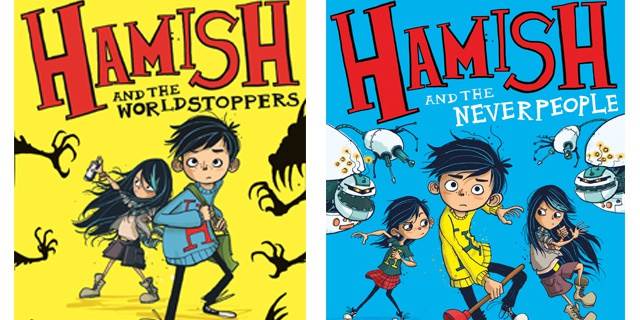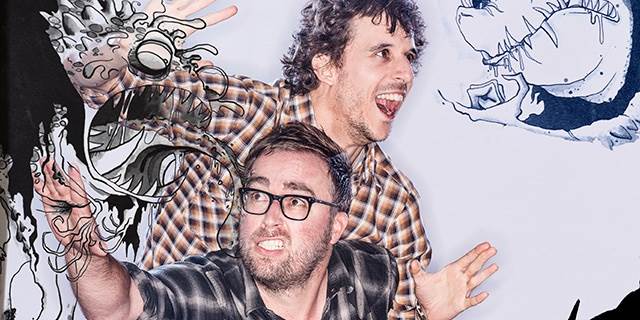Danny Wallace and Jamie Littler: Writing funny books for children
Published on: 19 April 2016 Author: Danny Wallace and Jamie Littler
Writer and illustrator team, Danny Wallace and Jamie Littler, talk about the best way to write funny books.
The pair, who have recently collaborated on Hamish and the Never People, also talk about their funniest books and the best things about writing for children.

What are your top three favourite funny children's books and why?
Danny Wallace: I'd say The Twits by Roald Dahl, which shows just how mean and stinky grown-ups can be - and how funny pointless revenge can be too!
The Astounding Broccoli Boy by Frank Cottrell Boyce, because everyone needs to know what they'd do if they turned green.
And I very much enjoy the Tom Gates books by Liz Pichon for the sheer number of ideas and funny moments in each one.
Jamie Littler: Oh man, that's a tough one! But literally reaching into my brain and picking three riiiight now, I would have to say the Mr. Gum series by Andy Stanton (illustrated by David Tazzyman) would be way up there. It's just so bonkers and off the wall, I think I laughed, often out loud like a loon, on nearly every page.
Another one I love is The Stinky Cheese Man and Other Fairly Stupid Tales, by Jon Scieszka (illustrated by Lane Smith). I LOVED this book as a kid (and an adult, which I am supposedly right now). It smashes every rule about how a bedtime story book should look and be read.
And last, but most certainly not least, is an absolute classic (and a bit of a cheat, as it's not one book but many), the books for children written by Roald Dahl (illustrated by Quentin Blake). They're brilliant, funny, gross and nasty (in a funny way, of course).
What's the best type of joke to write for children?
DW: Well, the temptation is to do lots of toilet humour, but I think that while kids enjoy those jokes, they're smarter than that. So I try and include lots of different types - wordplay, a funny image... and of course a *little* toilet humour. Failing that, make fun of their parents, their teachers, their siblings... and them!
JL: I always thought books had to be happy, frilly and lovely until I read these as a child, and was blown away by the world of dark humour.
What's the best thing about writing for children?
DW: The best thing is probably imagining them reading it. You need a strong hook - some big concept they can get lost in - and then to people it with characters they'll find silly, endearing or entertaining.
The next best thing is the reaction you get from them if they're into it. They want the next story immediately, and they'll start pitching you ideas for what it should be the second they meet you. I love that.
JL: The best type of joke to draw is one that is, in my opinion, one that is very visual. Hence why I'm drawing it! A crazy, funny expression on a character, something that just looks bizarre (like a poodle riding an inflatable camel through a fancy hotel), or a big, silly action scene (like a poodle riding an inflatable camel jousting with an elephant riding a unicycle.).
A good example in Hamish and the Never People is, at some point in the story, the characters have to dress up in disguises. Drawing these disguises and how each of the character's expressions reacts to having to wear them was a lot of fun.

How does writing funny scenes for children compare to writing comedy for adults? Are there things you write differently for children?
DW: I might find myself wording a sentence one way, and then think, 'no - what's the most direct way of getting to the joke?' Kids' books are shorter, and you want to pack the book full of funny scenes, big set-pieces and little moments so that you keep their eyes rolling along the pages until the very end.
And the good thing is, if you've created your world right, you can make almost anything happen. As big or as silly as you like.
JL: That they 'get' the finer things in life, like fun, imagination and silly antics Children don't approach a book with any pretentiousness or pre-conceptions, they just want to enjoy what they're about to read, no matter how far-fetched, unusual and bizarre the book is.
They can be harsh critics, they won't beat around the bush with reviews, they either like something or they don't, and being able to draw for that kind of authentic audience is always a challenge and a pleasure.
Also, I get to wake up in the morning and draw monsters and robots and characters going on adventures for a living, and I can't think of anything I'd rather be doing. Except maybe being a dragon rider, that would be pretty cool.
Describe a slapstick moment from your own life. Have you slipped on a banana skin, and was it really hilarious?
DW: I have never slipped on a banana skin, but a monkey once threw a ball at my head and then pretended he didn't. That was a wonderful moment. In fact, A Monkey Once Threw a Ball At My Head and Pretended He Didn't will be the name of my autobiography one day.
JL: I haven't myself, much to my eternal regret, but I was once on a camping trip with my friends, in deepest Cornwall, and my friend and I were talking about where that banana skin joke had come from, and whether someone had actually ever slipped over on a banana skin.
At that very moment my friend slipped over, right on his backside, on a banana skin. The banana skin had just been sitting there, in the middle of a field. Many people don't believe that story, but it's completely and honestly true. I'm surprised a clown didn't pop out of a bush and throw a pie at my face.
Topics: 6-8 years, 9-11 years, Funny, Interview, Reading for pleasure, Features





